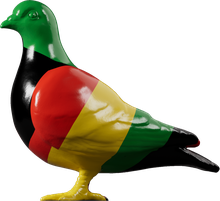Saxon & Medieval — Late Medieval; early-mid 14th century
St John the Baptist
The badge is in the form of a plaque with a gabled top. The sides and the base of the badge are decorated with a ladder-like motif. In the centre is the scene of St John the Baptist’s beheading. The saint is shown hanging upside down from his feet. A figure on the left holds St John’s head, almost bending it backwards. A man of the right is cutting through the saint’s neck with a large pointed knife. St John’s blood is being collected in a bowl underneath. There are traces of two stitching rings on the upper corners of the badge, which would have been used to sew the badge onto a pilgrim’s clothes. The reverse side of badge is decorated with cross hatching, worn away in the central area.Pilgrim badge from the shrine of St John the Baptist at Saint-Jean-d’Angely in France. The badge is in the form of a plaque with a gabled top. The sides and the base of the badge are decorated with a ladder-like motif. In the centre is the scene of St John the Baptist’s beheading. The saint is shown hanging upside down from his feet. A figure on the left holds St John’s head, almost bending it backwards. A man of the right is cutting through the saint’s neck with a large pointed knife. St John’s blood is being collected in a bowl underneath. There are traces of two stitching rings on the upper corners of the badge, which would have been used to sew the badge onto a pilgrim’s clothes. The reverse side of badge is decorated with cross hatching, worn away in the central area.
According to legend, the head of St John the Baptist was brought from Alexandria by a monk. Pepin II, the King of Aquitaine in France (died 864), established a monastery near his castle to house the head. This monastery was destroyed by Norse invaders in 860 but an abbot rediscovered the head 150 years later. However there was another head of St John the Baptist in Constantinople (it was later taken to Amiens) so there was always a doubt about the authenticity of the Saint-Jean-d’Angely relic. Only one other badge from this shrine has been found in London, also from the site at Vintry on the Thames foreshore. It is interesting that this site was the base of the medieval wine trade with France – perhaps people travelling to France on business found the time to take part in a pilgrimage as well.
- Category:
- Saxon & Medieval
- Object ID:
- 93.74
- Object name:
- St John the Baptist
- Object type:
- Artist/Maker:
- —
- Related people:
- Related events:
- Related places:
- Production date:
- Late Medieval; early-mid 14th century
- Material:
lead alloy, tin alloy, pewter
- Measurements/duration:
- H 39 mm, W 27 mm (overall)
- Part of:
- —
- On display:
- —
- Record quality:
- 100%
- Part of this object:
- —
- Owner Status & Credit:
Permanent collection
- Copyright holder:
digital image © London Museum
- Image credit:
- —
- Creative commons usage:
- —
- License this image:
To license this image for commercial use, please contact the London Museum Picture Library.

